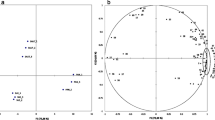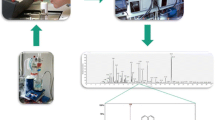Abstract
Trachanas is one of the most important traditional food products of Cyprus. It is made from fermented sheep or goat’s milk or a mixture of both. The fermented milk is heated and crushed wheat is added to produce a porridge mixture. The mixture is then dried and stored in the form of “biscuits”. Dehydration is performed either by sun, at a domestic level, or industrially using an oven. The objective of this study was to detect differences in aroma compounds of sun-dried or oven-dried Trachanas samples. Six samples (three sun-dried batches and three oven-dried batches) were prepared to make a porridge mixture according to the Cypriot tradition. Dried Trachanas samples were chemically analysed by the electronic nose SMart Nose system, by gas chromatography-mass spectrometry (GC/MS) and by gas chromatography-mass spectrometry-olfactometry (GC/MS/O). Triangle tests were also performed by a panel of 30 people from the CoRFiLaC staff in Ragusa, Italy. Principal component analysis applied to SMart Nose results showed a good separation between sun and oven-dried samples: Sun-dried samples showed a higher variability explained by the traditional process, in comparison to the oven-dried samples. GC/MS and GC/MS/O analysis showed higher numbers of compounds for the sun-dried Trachanas samples. In particular, double the number of odour active compounds were detected by GC/MS/O in the sun-dried samples, revealing that the use of the oven in the dehydration process generally resulted in a lower intensity of aroma. Triangle test confirmed instrumental results and clearly indicated detectable differences by consumers between sun- and oven-dried Trachanas.
Abstract
Trachanas 6 (3 3) (GC/MS) (GC/MS/O) Ragusa CoRFiLaC 30 GC/MS GC/MS/O Trachanas CGC/MS/O 2 Trachanas
Résumé
Le «Trachanas» est l’un des plus importants produits alimentaires traditionnels Chypriotes. Il est préparé à partir de lait de brebis et/ou de chèvre fermenté. Le lait fermenté est chauffé et mélangé à des flocons de blé, formant un mélange de type porridge. Le mélange est ensuite séché en forme de «biscuits». Le séchage est effectué, soit au soleil à l’échelle domestique, soit dans des fours pour les fabrications industrielles. L’objectif de cette étude était de déterminer les différences en composés d’arôme d’échantillons de Trachanas selon leur mode de séchage. Six échantillons (trois séries séchées au soleil et trois séries séchées au four) ont été comparés, le mélange lait-blé étant préparé selon la tradition chypriote. Les échantillons de Trachanas séchés ont été analysés par le système de nez électronique SMart Nose, par chromatographie en phase gazeuse — spectrométrie de masse (CPG/SM) et par CPG/SM — olfactométrie (CPG/SM/O). Des tests triangulaires ont également été effectués par un jury de 30 membres du personnel du CoRFiLaC, Ragusa, Italie. Les résultats d’analyse en composantes principales des données du SMart Nose montraient une bonne séparation entre les échantillons selon leur mode de séchage : les échantillons séchés au soleil montraient une variabilité plus grande, liée au procédé traditionnel, que les échantillons séchés au four. Les analyses CPG/SM et CPG/SM/O faisaient apparaître un plus grand nombre de composés volatils dans les échantillons séchés au soleil. En particulier, deux fois plus de composés odorants étaient détectés par CPG/SM/O dans les échantillons séchés au soleil, ce qui montre que le séchage des Trachanas en four conduisait à moins d’intensité aromatique. Les tests triangulaires confirmaient les résultats des analyses instrumentales et montraient que les échantillons séchés au soleil et les échantillons séchés au four étaient clairement différenciés par les consommateurs.
Similar content being viewed by others
References
Acree T.E., Barnard J., Gas chromatography-olfactometry using Charm analysis, in: Maarse H. (Ed.), Trends in flavour research, Proceedings of the 7th Weurman Flavour Research Symposium, 35, Elsevier, Noordwijkerhout, Amsterdam, Netherlands, 1994, pp. 211–220.
Agresti A., Two-way contingency tables, in: Agresti A. (Ed.), An introduction to categorical data analysis, John Wiley and Sons, Inc, New York, USA, 1996, pp. 39–44.
Arn H., Acree T.E., Flavornet, Worldwide Web resource: http://www.nysaes.cornell.edu/flavornet/ index.html, 1997.
Aruoma O.I., Cuppet S.L., Antioxidant methodology. In vivo and in vitro concepts, 1st edn., AOCS Press, Champaign, Illinois, USA, 1997.
Belitz H.D., Grosch W., Food chemistry, in: Hadziyev D. (Ed.), Aroma substances, Springer-Verlag, New York, USA, 1986, pp. 257–303.
Blandino A., Al-Aseeri M.E., Pandiella S.S., Cantero D., Webb C., Cereal-based fermented foods and beverages, Food Res. Int. 36 (2003) 527–543.
Gocmen D., Gurbuz O., Rouseff R.L., Smoot J.M., Dagdelen A.F., Gas chromatographic-olfactometric characterization of aroma active compounds in sun-dried and vacuum-dried Tarhana, Eur. Food Res. Technol. 218 (2004) 573–578.
Hayta M., Alpaslan M., Baysar A., Effect of drying methods on functional properties of Tarhana: a wheat flour-yogurt mixture, I Food Sci. 67 (2002) 740–744.
Ho C.T., Chen Q., Lipids in food flavours: an overview, in: Ho C.T., Hartman T.G. (Eds.), Lipids in food flavours, ACS Symposium Series 558, American Chemical Society, Washington, DC, USA, 1994, pp. 2–14.
Hsieh J.R., Contribution of lipoxygenase pathway to food flavours, in: Ho C.T., Hartman T.G. (Eds.), Lipids in food flavours, ACS Symposium Series 558, American Chemical Society, Washington, DC, USA, 1994, pp. 30–48.
Kose E., Cagindi O.Z., An investigation into the use of different flours in Tarhana, Int. J. Food Sci. Technol. 37 (2002) 219–222.
Lewinsohn E., Sitrit Y., Bar E., Azulay Y., Ibdah M., Meir A., Yosef E., Zamir D., Tadmor Y., Not just colors carotenoids degradation as a link between pigmentation and aroma in tomato and watermelon fruit, Trends Food Sci. Technol. 16 (2005) 407–415.
Marin A.B., Acree T.E., Barnard J., Variation in odor detection thresholds determined by Charm analysis, Chem. Senses. 13 (1988) 435–444.
McSweeney P.H.L., Sousa M.J., Biochemical pathways for the production of flavour compounds in cheeses during ripening: a review, Lait 80 (2000) 293–324.
Ministry of Finance Statistical Service, Republic of Cyprus, Worldwide Web resource: http://www.mof.gov.cy/mof/cystat/ statistics.nsf/index_en/ index_en, 2003–2008.
O’Mahony M., The binomial test: applications in sensory difference and preference testing, in: O’Mahony M. (Ed.), Sensory evaluation of food: statistical methods and procedures, Marcel Dekker Inc, New York, NY, USA, 1986, pp. 57–90.
Smit G., Smit B.A., Engels W.J.M., Flavour formation by lactic acid bacteria and biochemical flavour profiling of cheese products, FEMS Microbiol. Rev. 29 (2005) 591–610.
Author information
Authors and Affiliations
Corresponding author
About this article
Cite this article
Carpino, S., Rapisarda, T., Belvedere, G. et al. Effect of dehydration by sun or by oven on volatiles and aroma compounds of Trachanas. Dairy Sci. Technol. 90, 715–727 (2010). https://doi.org/10.1051/dst/2010027
Received:
Revised:
Accepted:
Issue Date:
DOI: https://doi.org/10.1051/dst/2010027




